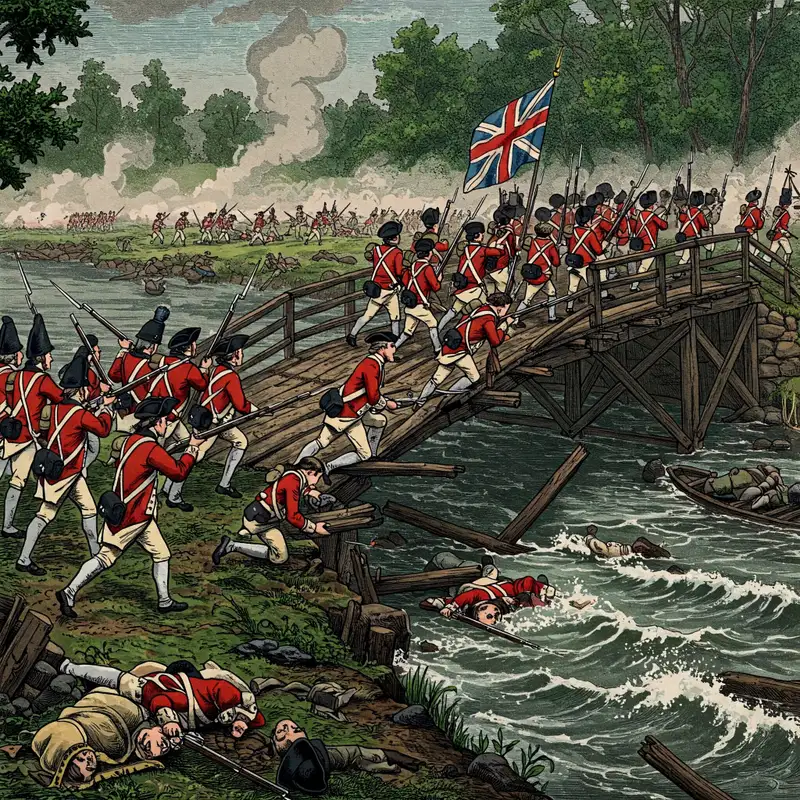Battle of Bound Brook
Welcome to History in 6 a place where we sample history in 6 minute increments. I'm your host Team Elendil and today in our journey through the American Revolutionary War we are going to (look at the Battle of Bound Brook). Time is short, let's jump into it.
The winter of 1776-1777 was harsh for both sides of the war. The Continental Army, despite its recent victories at Trenton and Princeton, was in a weakened state. Enlistments had expired, sending many soldiers back to their homes and families. For those that remained a smallpox epidemic swept through them, further diminishing their numbers. The British, for their part, were stationed in New Brunswick, New Jersey faced their own set of challenges. Their attempts to forage for supplies in the surrounding countryside had met with little success. They had 17,000 troops garrisoned there. And they found themselves in dire need of provisions, forcing them to resort to raiding local farms and merchants to sustain their forces. This "foraging war," brought hardship, suffering, and resentment to the people of Somerset County, who found their livelihoods and communities disrupted by the constant raids.
Which brings us to Bound Brook, a small town nestled on the Raritan River. It held a strategic position in those days between New York and Philadelphia. It was one of the few major bridge locations along the Raritan River. This made it a critical location for both sides, as control of Bound Brook could influence the movement of troops and supplies through the region. As such the town served as a forward base for the Continental Army, with an outpost responsible for patrolling three crucial bridges across the Raritan River. Any of these bridges were potential crossing points for the British should they attempt to advance on the main Continental Army encampment north in Morristown.
In February 1777, the Bound Brook outpost boasted a force of 1,000 men under the command of Major General Benjamin Lincoln. However, by mid-March, expiring militia enlistments had reduced this number to a mere 500. Lincoln was acutely aware of the vulnerability of his position. He expressed his concerns to General Washington. Noting that many of his units were too far away to provide timely assistance in case of an attack. In fact Lincoln kept wagons at the ready for a swift retreat if necessary.
As we will soon see this was a smart move because Lieutenant General Lord Charles Cornwallis who was commanding the British forces in New Jersey, had grown weary of the ongoing guerrilla warfare and sought to deliver a decisive blow against the Americans. He planned a reprisal action against the Bound Brook outpost, aiming to crush the American presence in the region and gain control of the key bridges.
As the first rays of dawn broke on April 13, 1777, the tranquility of Bound Brook was shattered by the sudden eruption of battle. Under the cover of darkness, approximately 4,000 British and Hessian troops had marched from New Brunswick. Their movements were cloaked from the Americans by the darkness of night. Cornwallis had divided his forces into four columns, each with a specific objective. Two columns advanced along both banks of the Raritan River, while a third contingent forded the river further upstream to attack from the west. The fourth column, intended to cut off the American retreat route, approached from the east.
The first shots were exchanged as the vanguard of the Hessian Field Jaeger Corps, led by Colonel Johann Ewald, encountered fierce resistance from the Americans defending the left bank of the Raritan River. Ewald, a skilled and experienced officer, had been tasked with leading a feint attack to distract the Americans from the main British advance. However, the intensity of the American defense caught him off guard. His jägers, though renowned for their marksmanship and agility, found themselves pinned down by a hail of musket fire.
Meanwhile, the main British force, under the command of Cornwallis and Colonel von Donop, pressed their attack. Donop's column stormed across the Queen's Bridge, while Cornwallis's troops, having successfully forded the river, descended upon the Americans from the west. The American forces, outnumbered and outmaneuvered, were caught completely by surprise. Amidst the chaos and confusion, General Lincoln with his ever ready wagons narrowly escaped capture. He was forced to flee in such haste that he left behind his personal belongings which included important military papers.
The British, having routed the Americans, seized control of Bound Brook. They captured cannons, ammunition, and supplies, and looted personal belongings and papers of those who fled including General Lincoln. However, their victory was short-lived. By the evening of the same day, they had withdrawn back to New Brunswick, leaving behind a scene of destruction and disarray. Major General Nathanael Greene, dispatched by Washington with reinforcements, arrived to reoccupy Bound Brook, finding the town deserted but for the carnage of the battle.
The Battle of Bound Brook, though brief and intense, resulted in significant casualties on both sides. Estimates of American losses vary, with some accounts placing the number of killed, wounded, or captured as high as 120 which was nearly a quarter of the men there. General Howe, in his official report, claimed that approximately 30 Americans were killed and 80 to 90 captured, while General Lincoln reported 60 of his men killed or wounded. Howe, downplaying the British losses, reported no deaths and only seven wounded among his own troops. Washington, in his report to the Board of War, acknowledged the loss of two cannons, two officers, and 20 men, but described the overall casualties as "trifling and not worth mentioning."
Despite their tactical victory, the British failed to capitalize on their success at Bound Brook. They did not press their advantage, choosing instead to withdraw to New Brunswick. This proved to be a strategic miscalculation, as it allowed the Continental Army to regroup and strengthen its defenses. Washington, recognizing the vulnerability of his outposts, ordered a consolidation of his forces. He also reduced the number of detached posts to prevent them from being overrun in similar surprise attacks.
As part of this consolidation and recognizing the difficulty of defending the Bound Brook, Washington withdrew the remaining garrison at Bound Brook on May 26th. A few days later, he moved a significant portion of his army from Morristown to a new encampment near Middle Brook, a more defensible position nestled between the first and second Watchung Mountain ranges4. This new encampment provided a strategic advantage, allowing Washington to monitor British movements and thwart their attempts to advance on Philadelphia.
If you have enjoyed this episode, tell a friend about us. If you haven't already, subscribe to get future content and as always have a great day if you want to.
If you have enjoyed this video hit the like button. Subscribe to get future content and as always have a great day if you want to

